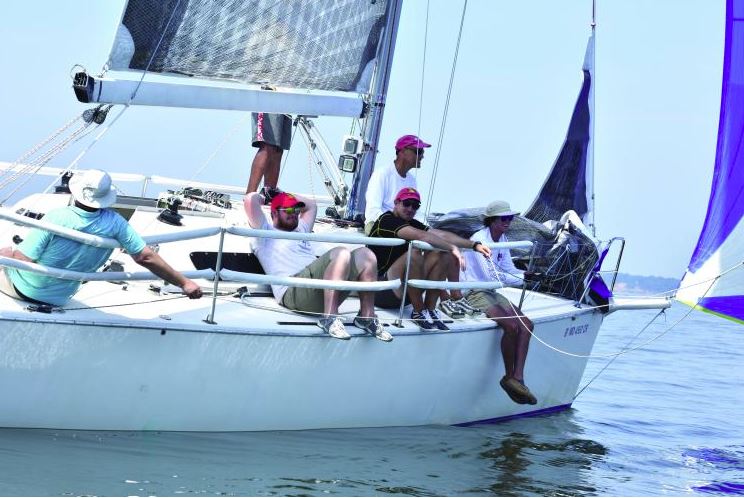Tips for Light-Air Sailboat Racing
As we move into proper summer conditions, it is going to get light and squirrely. These are the race conditions which will test patience and resolve, where it is easy to lose our cool and become frustrated. I used to dread light air, but then I made the Chesapeake Bay my home, and I had no choice but to attempt to get better at it. Here are a few thoughts to keep in mind as you attempt to master light-air races.

The first lesson of every talk on starting technique is a reminder to stay close to the line. In light air, this is even more critical. Being late is the most common mistake. As a corollary, make sure you are racing well before the five-minute gun. Keep the boat moving at top speed with optimized trim and weight placement throughout the starting sequence. Be aware of current, since its effect on boat speed is magnified at low speed. Are you getting carried over or held back? Stay up current.
In very light conditions, the safest pattern is to run back and forth from close reach to close reach. This is the fastest point of sail in light air and the one which will make it easiest to keep the boat moving. By repeating this pattern during the sequence you will also help your speed/time/distance calculation and get a feel for when you need to be turning back and going for it.
When cruising around the starting line, try to avoid getting caught up in a clump of boats. You want to stay out of crowds and be on your own. There is less breeze to go around in a pack, and you simply can’t live with another boat anywhere near you close to leeward if you are going to be reaching and building speed in the last minute. This also means you probably will not want to do use the classic tactic and start conservatively in the middle or in the boat or pin third. The surest way to clear air and the ability to put the bow down and accelerate is to start at the pin, or failing that, at the boat with a quick tack. Which end you choose comes down to which side of the course looks best. Light air starts require more commitment than normal. You just can’t be conservative.
Tactics: not for the faint of heart
As at the start, you are not going to win many light-air races by sailing up the middle. You really have to be ready to hit an edge. In normal races, wind shifts, pressure (velocity), and current are weighted relatively evenly. In light-air races, pressure and current dictate strategy.
Sail to the side where you think there is more wind and less adverse or more positive current. A small increase in wind velocity pretty much outweighs anything else. Don’t worry as much about the small wind shifts. The most difficult legs are the ones where the current says go one way and the velocity says go to the other side. Say you need to go left to get out of the current, but there seems to be more pressure to the right. To hedge your bets, a good place to be would be to the right of the bulk of the fleet as you head left, shepherding them to the current-favored side while staying closer to better pressure.
Upwind: help your helmsperson, speed first, use your weight
While sailing upwind in moderate conditions, headsail trim doesn’t change much once base trim is established. The helmsperson steers to the sail and angle of heel, and it’s pretty much in their hands. In light, puffy, shifty conditions, the headsail trimmer and the driver have to work together. Changes in velocity and direction will demand big changes, too big for just the driver to correct.
In a puff, the apparent wind will move aft, and the headsail will need to be eased as well as having the driver head up so you don’t try to make too fast a course correction. As the boat comes up to meet the new wind angle, the headsail can be trimmed back in.
In a lull, the opposite will be true. The apparent wind will shift forward. Trim the headsail in (even if over-trimmed momentarily) so that it doesn’t luff and slowly turn the boat down. Don’t turn down suddenly or hard. Just let the boat coast and bear off gently. As the boat slows, the apparent wind will go aft, and the sail can be eased back out. Above all, do not get greedy! In the puffs, go for speed first and only come up gradually so you don’t overshoot the best angle.
The other thing which helps the helmsperson is heel. Heel creates weather helm and helps with feel. Keep the weight forward and to leeward. Most racer/cruisers have relatively small cockpits which tend to attract lots of bodies. Get them out of the cockpit and forward up by the shrouds. It’s okay and often a lot more comfortable to go down below. Who wants to watch anyway? Food can be a good incentive. In the puffs, slide a body or two at a time up to maintain a consistent angle of heel. Finally, movement kills speed, so everyone needs to stay frozen in place. When movement is necessary, move like a cat.
Questions? email [email protected]
Find more racing tips here.




